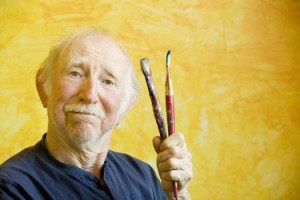 For some people, art is a vocation. For others, it’s a pleasant hobby. But no matter what our reasons for drawing, painting, sculpting or doing needlework, creating art offers many benefits for our minds, bodies and spirits.
For some people, art is a vocation. For others, it’s a pleasant hobby. But no matter what our reasons for drawing, painting, sculpting or doing needlework, creating art offers many benefits for our minds, bodies and spirits.
Consider these cases:
- An 82-year-old man, recently widowed, is suffering from depression. Encouraged to join a painting class at his local senior center, he finds himself expressing his sense of loss through his artwork, and begins to enjoy interaction with others in his class.
- A 71-year-old stroke patient struggles to improve coordination in her left hand. Writing is frustratingly difficult. But with the help of an art therapist, she discovers that the freedom of motion involved in wielding a paintbrush helps increase her coordination.
- A cancer patient, 64, who is undergoing chemotherapy, is invited to work with watercolors while she is in the hospital. She reports experiencing lessened side effects while she is immersed in the distraction of painting.
It has long been known that for people of every age, the act of creating is life enhancing and nourishing to the human spirit. For older adults, research demonstrates that participating in artistic expression provides many benefits:
Recreation.
Creating a craft project, making decorations for a special event, illustrating a thought, making something to give as a gift creating artwork is a pleasurable way to spend leisure time.
Self-Expression.
By making a work of art, we announce: “This is who I am. This is what I have to say.” Expressive art can provide vivid access to memories, and is a useful starting point for reminiscence and life review. The act of creating allows us another way to share our lives.
Communication.
People who have difficulty expressing themselves verbally are often able to communicate through visual means. For people with Alzheimer’s disease or other conditions that cause speech difficulty, visual art can provide an alternative to verbal communication. A picture can indeed be worth 1,000 words.
Socialization.
Art is a way of introducing ourselves to others. People are more likely to “come out of their shells” during shared experiences of play, fun and spontaneity. Friendships grow during cooperative projects, or just from working side by side.
Intellectual Stimulation.
The act of creating is a great way to exercise the brain. Deciding what media to use, what to draw or paint, where to put the first line all provide mental exercise. An art project can represent a stimulating challenge to be met, increasing orientation and awareness.
Emotional Well-Being.
Making an artwork taps into our emotions and allows us to better feel and express them. Art activity has been shown to decrease stress and depression. And self-esteem is enhanced through the sense of accomplishment that comes with creating something.
Physical Benefits.
Drawing, sculpting or assembling artwork is beneficial to coordination and small motor movements. Focusing on creative effort has also been shown to help lessen physical pain.
Art programs are available for people with every level of skill and ability who wish to participate, no matter their physical or cognitive challenges. To locate art opportunities in your community, consider adult day centers, senior centers, community colleges, community education and lifelong learning classes, or your local parks and recreation department. Many art museums today offer outreach programs, some designed for people with memory loss.
Trained art therapists also offer sessions, either privately or through healthcare organizations. You can learn more on the website of the American Art Therapy Association.
Source: Regency Memory Club in association with IlluminAge. Copyright 2015 IlluminAge
